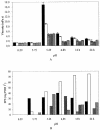Biodiversity of exopolysaccharides produced by Streptococcus thermophilus strains is reflected in their production and their molecular and functional characteristics
- PMID: 14766570
- PMCID: PMC348814
- DOI: 10.1128/AEM.70.2.900-912.2004
Biodiversity of exopolysaccharides produced by Streptococcus thermophilus strains is reflected in their production and their molecular and functional characteristics
Abstract
Twenty-six lactic acid bacterium strains isolated from European dairy products were identified as Streptococcus thermophilus and characterized by bacterial growth and exopolysaccharide (EPS)-producing capacity in milk and enriched milk medium. In addition, the acidification rates of the different strains were compared with their milk clotting behaviors. The majority of the strains grew better when yeast extract and peptone were added to the milk medium, although the presence of interfering glucomannans was shown, making this medium unsuitable for EPS screening. EPS production was found to be strain dependent, with the majority of the strains producing between 20 and 100 mg of polymer dry mass per liter of fermented milk medium. Furthermore, no straightforward relationship between the apparent viscosity and EPS production could be detected in fermented milk medium. An analysis of the molecular masses of the isolated EPS by gel permeation chromatography revealed a large variety, ranging from 10 to >2,000 kDa. A distinction could be made between high-molecular-mass EPS (>1,000 kDa) and low-molecular-mass EPS (<1,000 kDa). Based on the molecular size of the EPS, three groups of EPS-producing strains were distinguished. Monomer analysis of the EPS by high-performance anion-exchange chromatography with amperometric detection was demonstrated to be a fast and simple method. All of the EPS from the S. thermophilus strains tested were classified into six groups according to their monomer compositions. Apart from galactose and glucose, other monomers, such as (N-acetyl)galactosamine, (N-acetyl)glucosamine, and rhamnose, were also found as repeating unit constituents. Three strains were found to produce EPS containing (N-acetyl)glucosamine, which to our knowledge was never found before in an EPS from S. thermophilus. Furthermore, within each group, differences in monomer ratios were observed, indicating possible novel EPS structures. Finally, large differences between the consistencies of EPS solutions from five different strains were assigned to differences in their molecular masses and structures.
Figures




References
-
- Almirón-Roig, E., F. Mulholland, M. J. Gasson, and A. M. Griffin. 2000. The complete cps gene cluster from Streptococcus thermophilus NCFB 2393 involved in the biosynthesis of a new exopolysaccharide. Microbiology 146:2793-2802. - PubMed
-
- Broadbent, J. R., D. J. McMahon, C. J. Oberg, and D. L. Walker. 2001. Use of exopolysaccharide-producing cultures to improve the functionality of low fat cheese. Int. Dairy J. 11:433-439.
-
- Bubb, W. A., T. Urashima, R. Fujiwara, T. Shinnai, and H. Ariga. 1997. Structural characterisation of the exocellular polysaccharide produced by Streptococcus thermophilus OR901. Carbohydr. Res. 301:41-50. - PubMed
-
- Courtin, P., V. Monnet, and F. Rul. 2002. Cell-wall proteinases PrtS and PrtB have a different role in Streptococcus thermophilus/Lactobacillus bulgaricus mixed cultures in milk. Microbiology 148:3413-3421. - PubMed
-
- Degeest, B., and L. De Vuyst. 1999. Indication that the nitrogen source influences both amount and size of exopolysaccharides produced by Streptococcus thermophilus LY03 and modelling of the bacterial growth and exopolysaccharide production in a complex medium. Appl. Environ. Microbiol. 65:2863-2870. - PMC - PubMed
Publication types
MeSH terms
Substances
LinkOut - more resources
Full Text Sources
Other Literature Sources
Molecular Biology Databases

